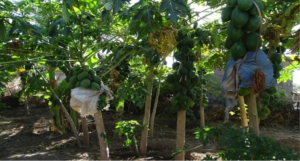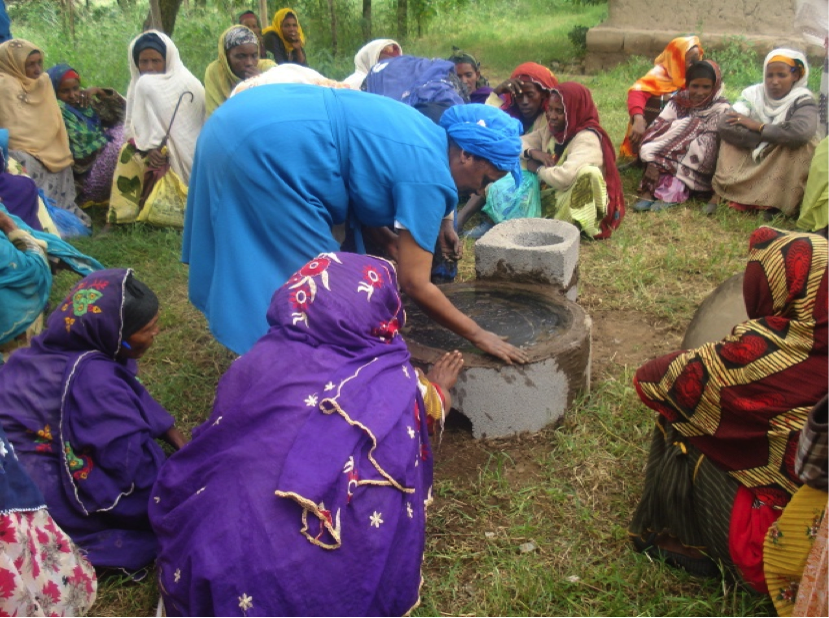![]() This article is part of our Editorial Series called “GFAR impakters”. This is done in partnership with GFAR – The Global Forum on Agricultural Research and Innovation – For more follow on Twitter: #GFARImpakters or view here.
This article is part of our Editorial Series called “GFAR impakters”. This is done in partnership with GFAR – The Global Forum on Agricultural Research and Innovation – For more follow on Twitter: #GFARImpakters or view here.
The wildlife sanctuary in the Dhera Block of Arsi Mountains National Park in the Oromia region, Ethiopia, hosts a variety of acacia-dominant vegetation cover and is the habitat for over 25 wild mammals dominated by greater kudu, lesser kudu, spotted hyena and warthogs. The park is also home to more than 189 bird species including helmeted guinea fowl, little bee eater, black wood hoopoe, grey wood pecker, grey headed sparrow and more. Beyond its multiple ecological benefits in the current context of climate change, the park has high tourism potential.
Regardless of these golden opportunities, both the biodiversity and wildlife in the park encounter multiple challenges, from environmental degradation aggravated by climate change, to population pressure, poverty and a lack of alternative energy sources for the local communities. This creates a severe strain and pressure on the vegetation cover of the park and a loss of habitat for wildlife.
 In the photo: Biodiversity at the wildlife sanctuary, Arsi Mountains National Park Photo credit: ASDA
In the photo: Biodiversity at the wildlife sanctuary, Arsi Mountains National Park Photo credit: ASDA
The Association for Sustainable Development Alternatives (ASDA) became operational in 2006 to address these issues. It also aims to assist vulnerable communities in and around the wildlife sanctuary and to build community resilience through the promotion of integrated rural development. The partnership has resulted in increased production, enhanced coordination and interagency collaboration for synergy development, public-private partnership and climate change adaptation practices.
To promote community-based rehabilitation, the conservation of biodiversity, tourism development and environmentally friendly alternative livelihoods, ASDA has been implementing diverse response measures in the following major intervention components.
Agriculture-based Livelihoods
Although Dodota, Oromia, suffers from food insecurity, massive deforestation and attendant land degradation, it also has good agricultural potential particularly in areas where irrigated agriculture is possible. Accordingly, ASDA promoted vegetable production, agroforestry, small ruminant rearing (of sheep and goats) and poultry keeping to provide alternative livelihoods rather than fuel wood and charcoal selling.

In the photo: Women in agroforestry Photo Credit: ASDA
Leadership Development and Community Mobilization for Natural Resource Managemen
ASDA has organised a series of community based biodiversity and wildlife conservation sensitization workshops and stakeholders’ consultation forums and training. A woreda-level (district) advisory committee and kebele-level (ward) technical working groups were established. Furthermore, we established community user groups who protect the park and benefit from its resources through a cut and carry system rather than unrestricted open overgrazing
Experience sharing visits to Semien Mountains and Bale National Parks were organized to draw lessons on good practices in community based biodiversity conservation and ecotourism development.
In addition to this:
- One community dialogue centre has been renovated and furnished to promote continued community-wide discussions on park protection, NRM, livelihood diversification, gender and other development issues;
- 10 school environmental clubs with memberships of over 1200 were established to work on park and environmental issues. Training and natural resources management were given to the schoolchildren, allowing them to be agents of park protection;
- Gullies and deforested areas were promoted to reduce land degradation and soil erosion in and around the park and to allow the rehabilitation and conservation of degraded areas;
- A park protection and ecotourism cooperative was established with a membership of 103, of which 27 are women.
Poverty Reduction through Alternative Livelihoods Diversification
To reduce dependency on the park and to motivate local communities to be engaged in the park protection initiative, some alternative livelihood measures were promoted. This included the establishment of seedling and improved stoves production and marketing Women Groups as IGAs.
Promotion of Tourism Potential of the Par
Access roads, 15 km trial systems, and 5 fords were constructed to facilitate comfortable trekking and driving in the park. Camp sites and toilets were also constructed.
In addition, to promote the park‘s tourism potential, we developed and distributed promotional materials including flyers (made with the best flyer maker), brochures, booklets, posters, billboards and documentary DVDs. We also organized World Tourism Day celebration events and regional multi stakeholder consultation forums.
ASDA’s initiative at Dodota was identified as a potential good practice intervention that brought together integrated food and livelihood security, women’s and youth economic empowerment, environment and biodiversity conservation and tourism development by a national civil society Umbrella organization. CCRDA assessed the project and ASDA stood top performing.
What impact has this had?
The agriculture based livelihood diversification activities involving vegetable, fruits and improved poultry production have been adopted by more than 65 percent of the target communities as an integral part of their farm activities. These have had a significant impact on their overall production and productivity, as well as on HH food and nutrition security.
The alternative livelihood activities have played an important role in motivating and mobilizing communities to stand in favour of park protection. The thematically arranged training activities have well equipped and resulted in significant changes in the knowledge, skills, attitude levels and overall performances of target farmers, DAs and experts on vegetable fruit and poultry production, agroforestry and related areas.
The organization and establishment of women into IGA self-help groups along with capacity building training packages in entrepreneurship, business, leadership and technical areas has also provided a significant contribution in reducing the multiple problems poor women encounter and the overall park protection and promotion initiative. The two Women Groups involved in improved stoves production and marketing have produced over 3000 fuel efficient stoves. Today, almost every HH in the project area has at least one improved stove. The initiative has significantly reduced deforestation rates and the burden on women in search of fuel wood. Moreover, ease of cooking is highly improved with no smoke, which has become the root of serious eye complications in the area. Women Groups engaged in seedling production could produce over 50,000 seedlings and supply to the project and individuals. About 110 women who were engaged on sheep fattening and production own more than 15 goats and sheep against the initial four sheep purchased and given. Some of the beneficiaries reinvested into horse trailed passenger carts, small consumer shops and grain marketing. Many have replaced their grass roofed houses with iron sheet houses and are sending their children to school.
Illegal tree cutting, illegal cut and carry and grazing and wildlife car accidents are almost at zero now because of the availability of water in the park.
 In the photo: Arsi Traditional Food exhibition on World Tourism Day Photo Credit: ASDA
In the photo: Arsi Traditional Food exhibition on World Tourism Day Photo Credit: ASDA
The World Tourism Day celebrations and other promotional initiatives, training and exposure visits have significantly enhanced the management, leadership and institutional capacity, and have established an excellent public image and recognition of the Park as a competent tourist attraction centre by zonal, regional and federal authorities.
Other achievements of ASDA
We have focused on community-based biodiversity and wildlife conservation and tourism development in the context of climate change, new thinking for the area given that agriculture is an unreliable source of income due to erratic rainfall and long dry spells. The alternative livelihood diversification and women-managed improved stoves promotion initiatives of the organization have significantly reduced community pressures on the park and have motivated target farmers to actively engage in the park protection initiative.
Institutionalizing park resource management and benefit sharing through the development of by-laws have encouraged the local people to be part of the park protection and tourism development initiative. The introduction and promotion of Enset (false banana) production as an agroforestry and climate change adaptation package has proved successful as the crop has high drought tolerance capacity. Linking the park with Sodere resort and other big hotels in Adama has great potential to promote conference tourism.
Related Articles:
![]() “SWIMMING AGAINST THE CURRENTS: SUSTAINABLE AGRICULTURE IN AN AGE OF COMMERCIAL FARMING” by Dr. Vanaja Ramprasad
“SWIMMING AGAINST THE CURRENTS: SUSTAINABLE AGRICULTURE IN AN AGE OF COMMERCIAL FARMING” by Dr. Vanaja Ramprasad
![]() “AN NGO PRESERVES A COUNTRY’S BIODIVERSITY IN KYRGYZSTAN” by Alima Arbudu
“AN NGO PRESERVES A COUNTRY’S BIODIVERSITY IN KYRGYZSTAN” by Alima Arbudu
The achievements of ASDA in and around Dhera park are highly promoted to the wider public through different media and are easily adaptable to different contexts where such parks are available. The key strategy is bringing the local people at the center of the biodiversity conservation initiative. The alternative livelihood initiatives are already adopted by most farming HHs in the area and linkage is already created with Melkassa research center for technical support. ASDA is also planning to scale up its best practices in community based biodivesity and wild life conservation to the rest of the three blocks of Arsi Mountains National Park that connect 14 districts given the availability of funds.
A lot has been done to ensure the continuity of ASDA’s initiatives once the project phases out. The community participation and involvement right from the design stage resulted in building sense of ownership and responsibility. Kebele level park protection working groups, community based park protection and ecotourism cooperatives will keep promoting the park protection inintiative.
The local institutions including women improved stoves, seedling production and fattening initiatives proved to be viable and will keep enabling their members to generate income and the community to have continued access to improved stoves and seedlings after the project phases out. Training and leadership development and other capacity building elements were in-built in the project implementation process to enhance the capacity of the local communities. Community dialogues and exposure visits have enhanced cross fertilization of best practices.
 In the photo: Improved stone production Photo Credit: ASDA
In the photo: Improved stone production Photo Credit: ASDA
District line offices, especially the Agriculture & OFWE (Oromia Forestry and Wildlife Enterprise) Offices, complement project staff in offering technical support and training to farmers and DAs. They assist project staff in ensuring coordination and synergy with local government plans and are involved in project monitoring and evaluation. Woreda experts, kebele authorities and village park committees are involved in identifying and targeting beneficiaries on the basis of commonly agreed criteria and propose households to be targeted under each intermediate result areas. They are furthermore involved in community mobilization for project activities and the enforcement of Park Management bylaws, although not yet finalized and proclaimed.
In the implementation of program activities, care is given to incorporate gender issue into all the project activities. This emphasis was reinforced through the collection and analysis of gender-disaggregated data. At the community level, the project promotes equitable participation of men and women in all aspects of project planning, implementation and monitoring. The inclusion of women in all project activities was encouraged.
What next?
Participatory natural resource management engaging resource users and promoting equitable benefit sharing proved successful. Some of the other conclusions we came to were:
- Alternative livelihoods diversification reduced huge pressure that affect the environment
- Capacity development and inter-agency collaboration generated synergy
- Ethiopia is a land of biodiversity with huge and diverse tourist attraction to develop the smokeless industry and diversified jobs. Hence, multi-agency collaboration (government, UN agencies, bilateral and multi lateral organizations, hotels, tour operators and media, etc.) are of paramount importance to identify destinations, develop management plans, marketing strategies and capacity development in the field in order to tap the tourism potential including conference tourism
- Natural resource management and biodiversity conservation cannot be achieved by annual small grant. It requires multi – year funding and landscape approach to promote integrated development for impact. Hence allocation of resources for at least 3-5 years is required
- Arsi Mountains National Park is the birth place of world class Ethiopian athletes such as Haile Gebreselassie, Derartu Tule, Tirunesh and the Dibaba family, Kenenisa, Gezahegn Abera. This might create additional attraction to tourists besides its proximity to Addis. They can also be used as ambassadors of tourism in Ethiopia
- Further strengthening research/academia-extension service and farmers linkage would enhance technology generation, dissemination and adoption



 In the photo: Biodiversity at the wildlife sanctuary, Arsi Mountains National Park Photo credit:
In the photo: Biodiversity at the wildlife sanctuary, Arsi Mountains National Park Photo credit:  In the photo: Arsi Traditional Food exhibition on World Tourism Day Photo Credit:
In the photo: Arsi Traditional Food exhibition on World Tourism Day Photo Credit:  In the photo: Improved stone production Photo Credit:
In the photo: Improved stone production Photo Credit: 






